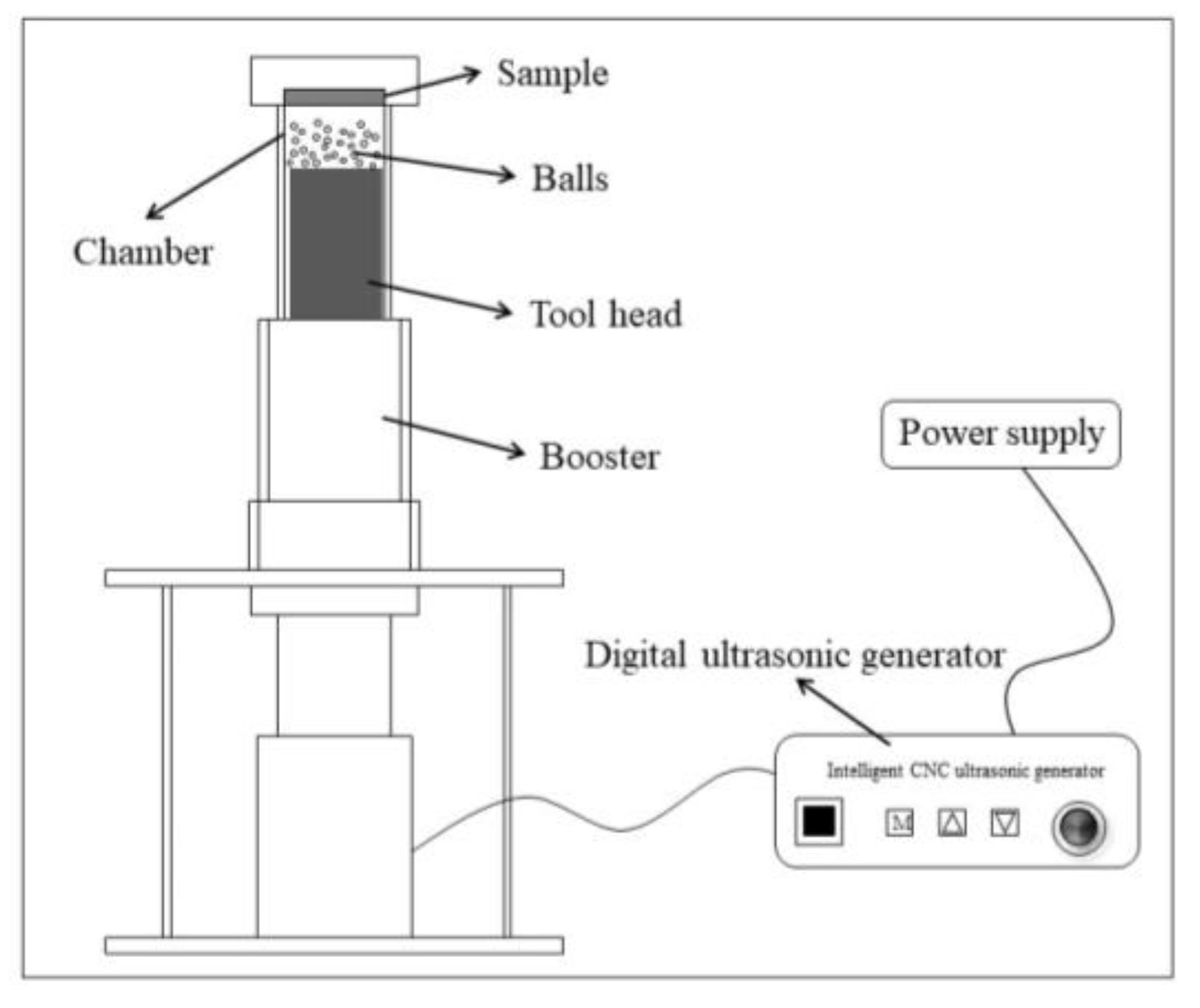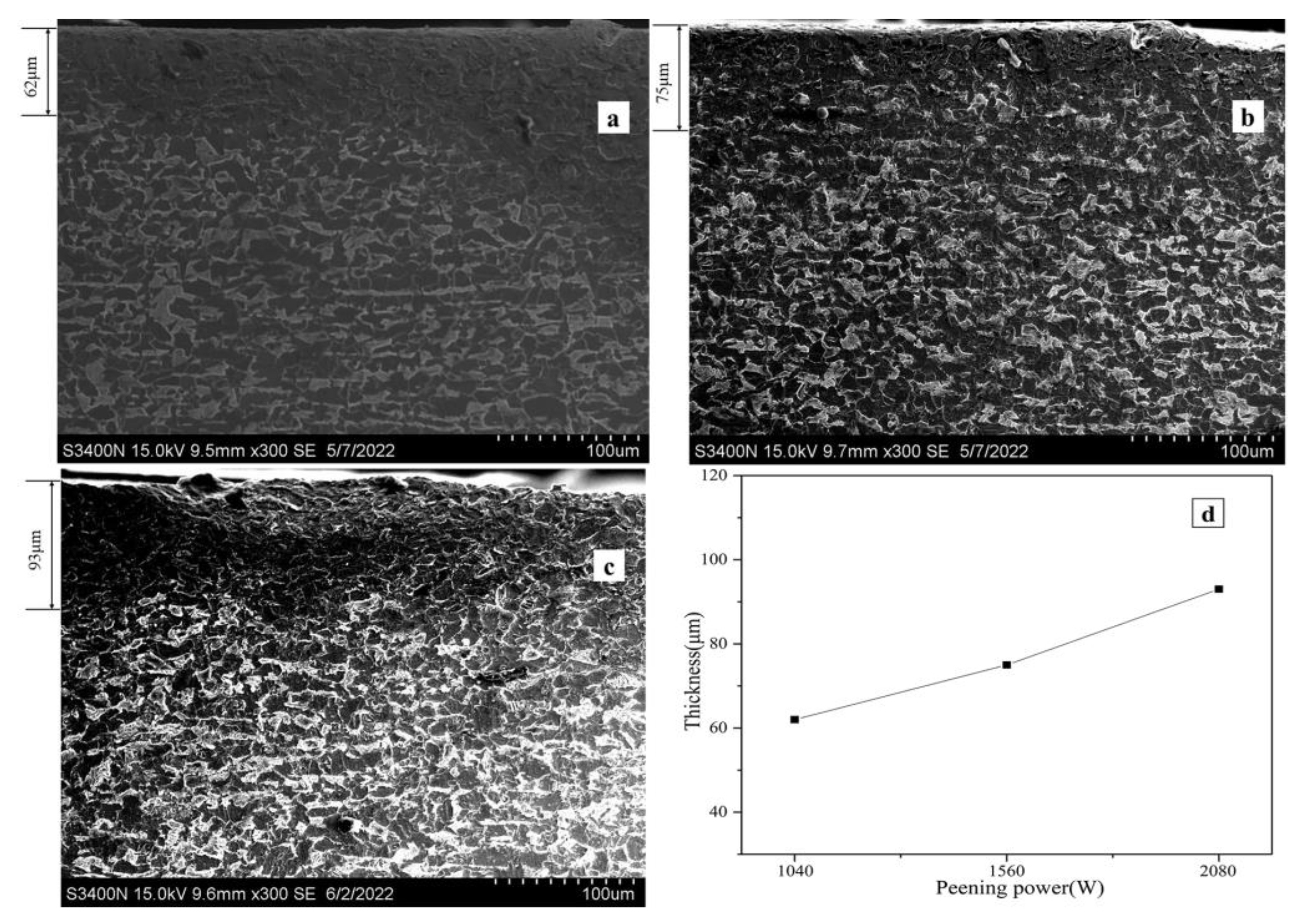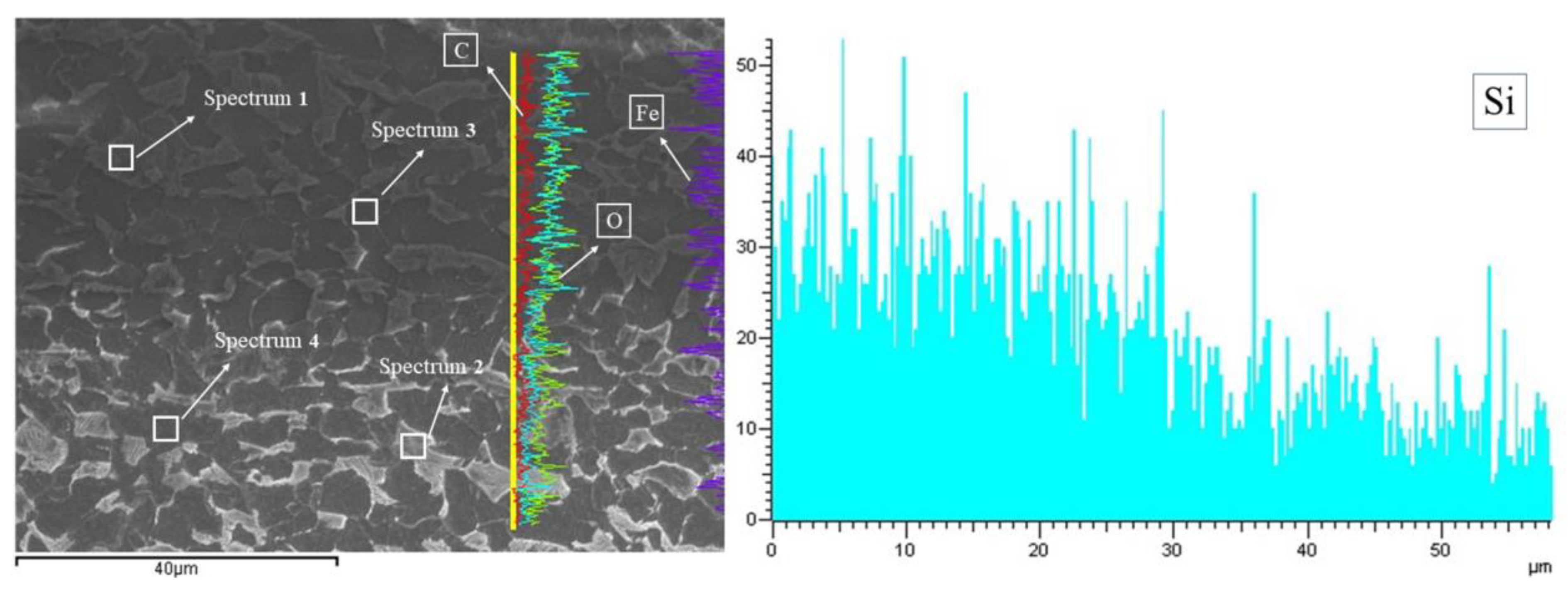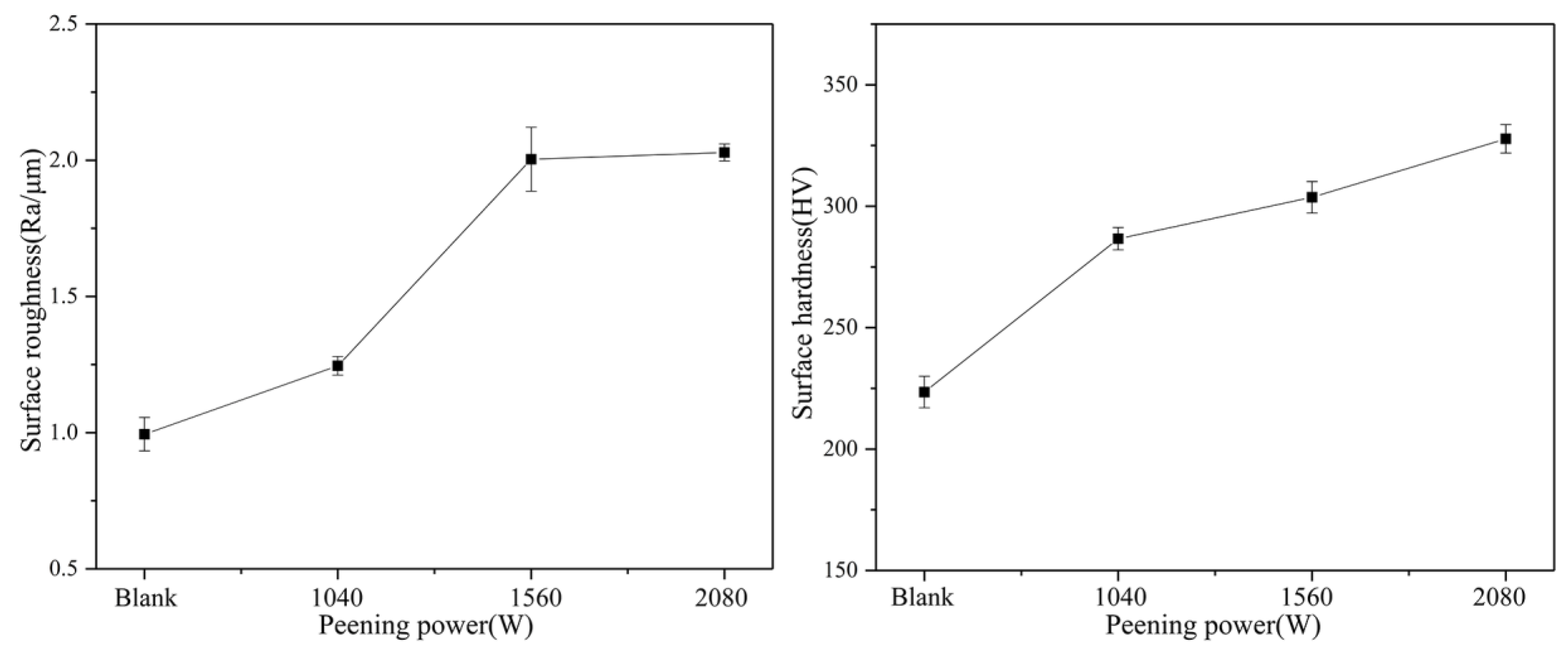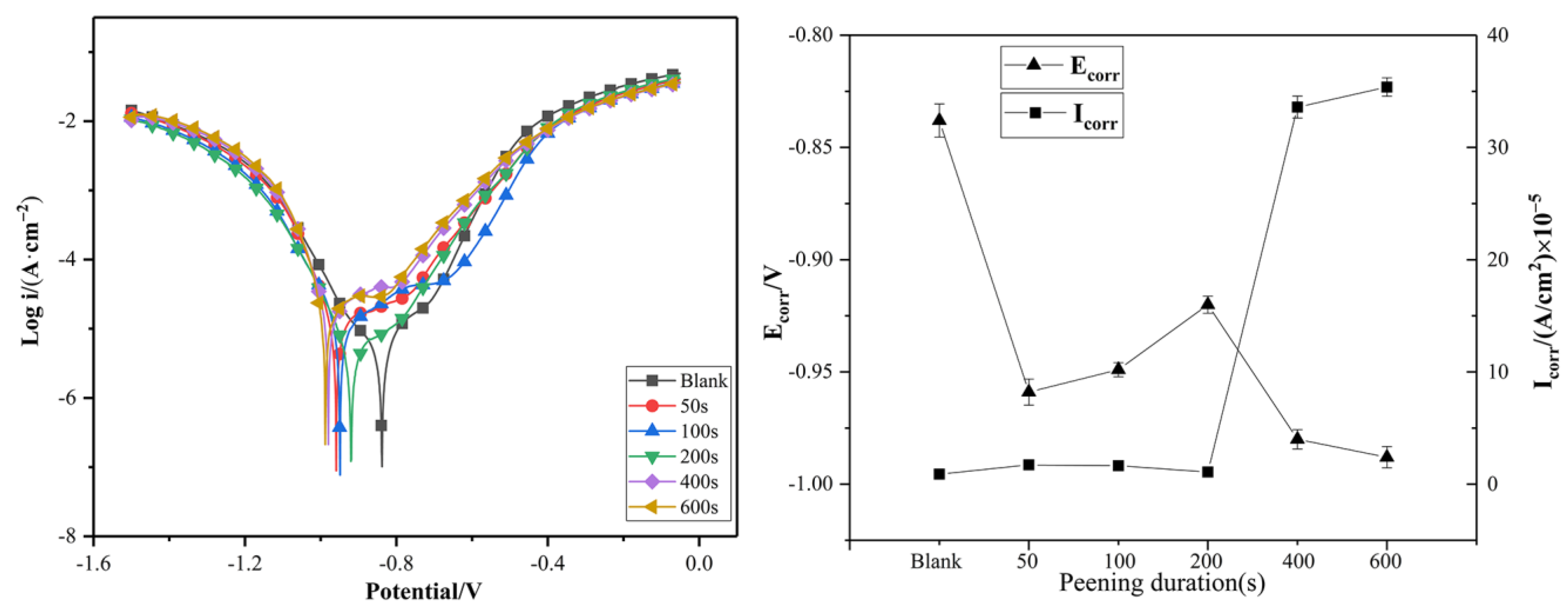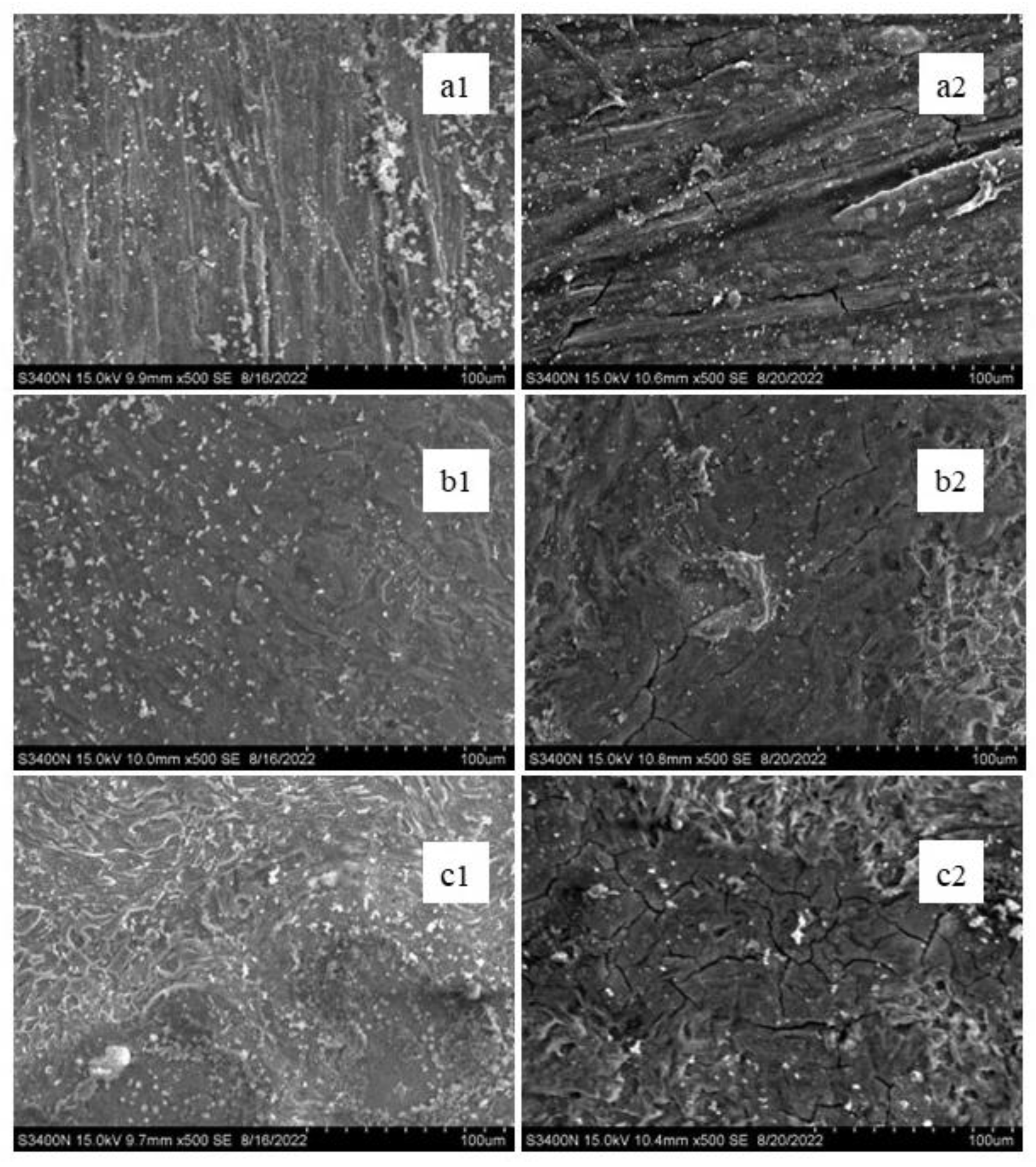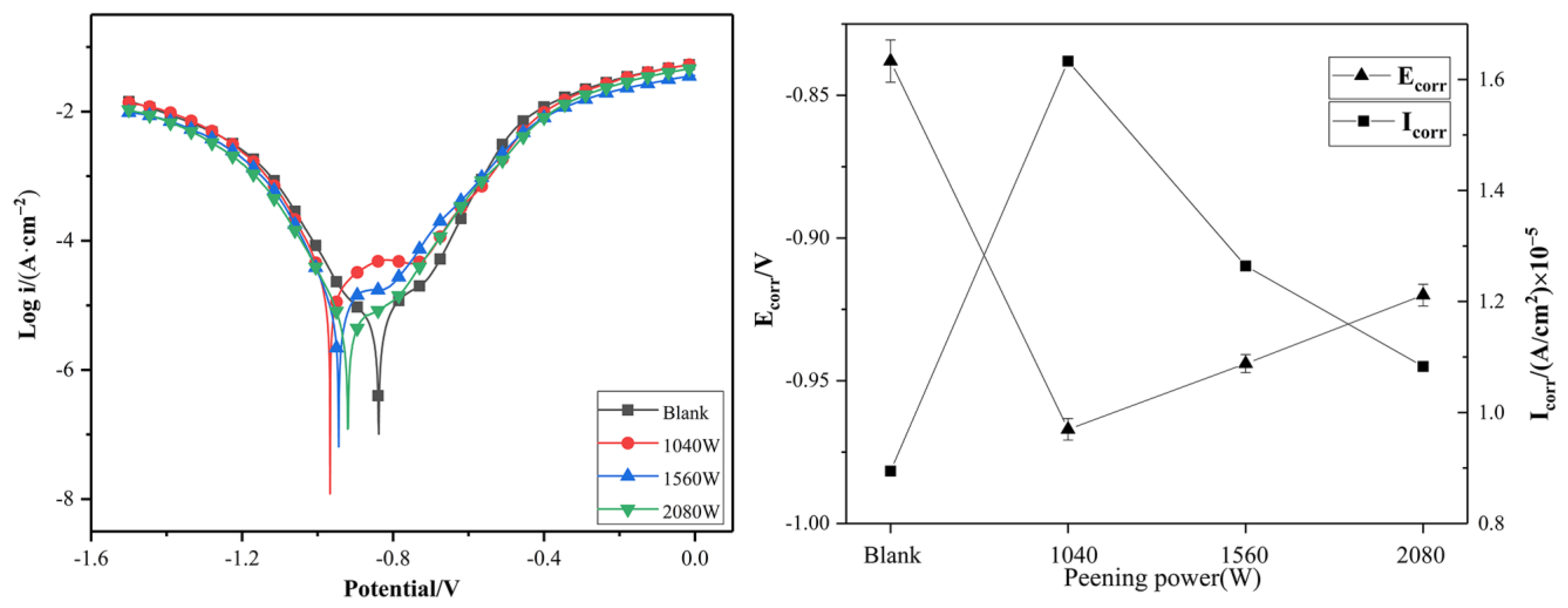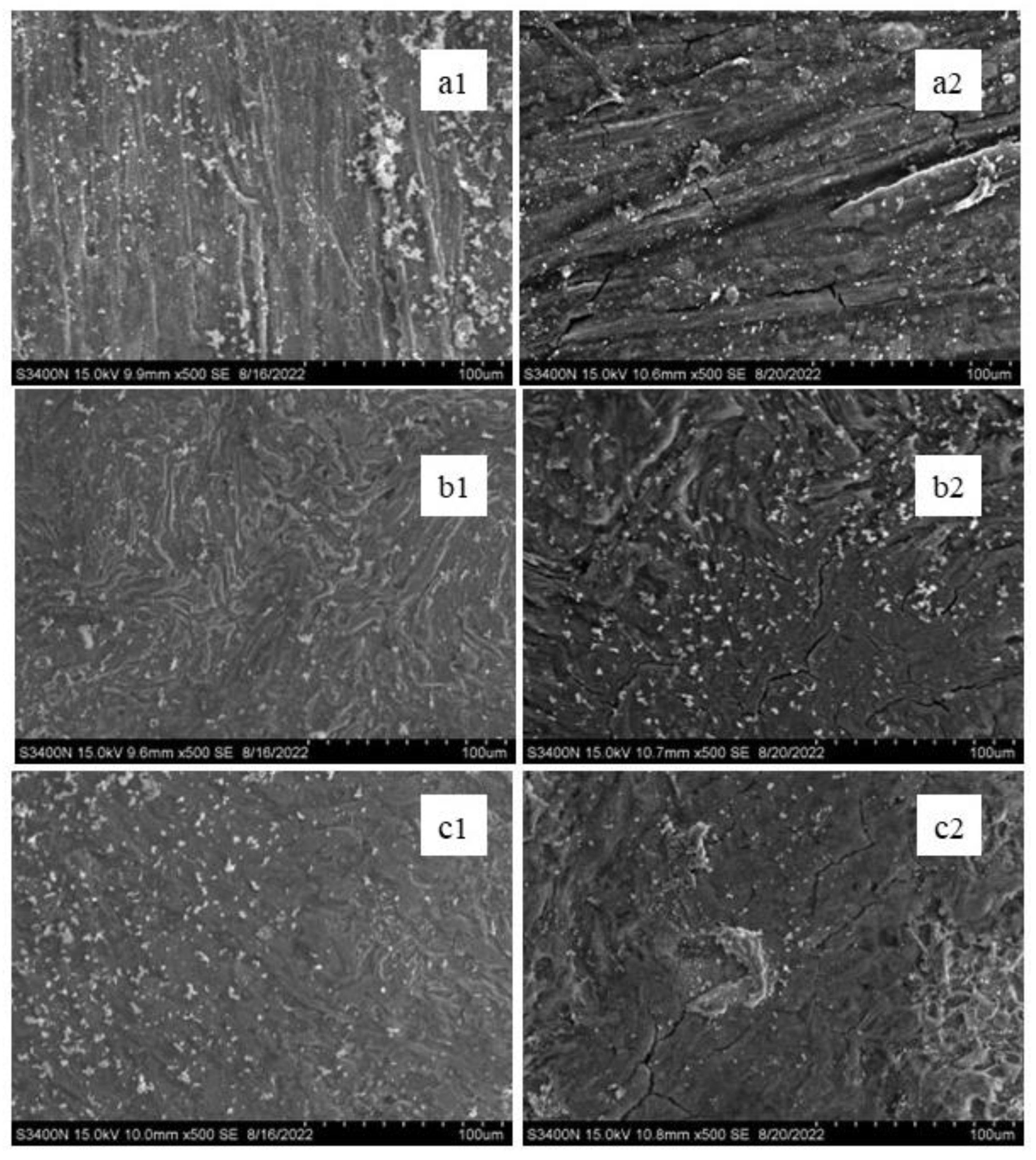3.1. Microstructure
Figure 2 shows the cross-sectional SEM microstructure of the samples after USP treatment with different lengths of time, and the thickness statistics of the deformed layers are shown in
Figure 2f. The grains on the surface layer of the sample were obviously refined [
8,
9], and the thickness of the deformed layer gradually increased as the USP time grew. From 50 s to 100 s, the thickness of the refinement area increased rapidly from 38 μm to 85 μm. Then, as the USP time increased, the growth in the deformation layer thickness slowed down, and from 100 s to 600 s, the thickness only increased from 85 μm to 104 μm. With the increase in the USP time, the impact of the steel ball on the surface of the samples increased; meanwhile, the plastic deformation increased, resulting in the enhancement of the work hardening. At the later USP stage, the plasticity of the samples’ surface was lost, and the growth rate of the deformed area thickness slowed down.
Figure 3 shows the cross-sectional SEM microstructure of the samples after USP treatment with different levels of power. Additionally, the thickness statistics of the deformed layers are shown in
Figure 3d. With the increase in USP power, the thickness of the deformed layer increased gradually. Additionally, when the USP power increased from 1040 W to 2080 W, the thickness of the deformed layer proportionally increased from 62 μm to 93 μm. The higher USP power provided a higher-energy steel ball to the samples’ surfaces, resulting in increases in the plastic deformation and the thickness of deformed layers.
Figure 4 shows the cross-sectional SEM microstructure of the samples after USP treatment with different distances, and the thickness statistics of the deformed layer are shown in
Figure 4d. The thickness of the deformed layer increased gradually as the distance decreased. As the USP distance decreased from 11 mm to 8 mm, the thickness of the deformed layer drastically increased from 93 μm to 155 μm, which indicated that the USP distance had an evident impact on the deformed layer thickness. The smaller the USP distance was, the more times the steel ball hit the sample, the smaller the shot gravity, and the lower the energy loss, resulting in higher energy acting on the sample.
As the plastic deformation increased, the dislocations increased, and the slip refined the original equiaxed grains. The increase in the hardness of the layer generated a large number of twins, which refined the grains, increased the number of grain boundaries and significantly improved the strength of the samples’ surface layer. The greater the energy of the USP was, the more serious the plastic deformation that occurred and the higher the degree of the grain refined on the samples’ surface.
Figure 5 shows the cross-sectional SEM image and EDS analysis of the sample after 3 mm-2080 W-11 mm-400 s (diameter-power-distance-time) USP treatment. An obvious delamination phenomenon and chemical composition difference appeared between the deformed layer and the substrate. The chemical compositions of the pearlite area and the ferrite area on the deformed layer and the substrate are listed in
Table 4. The pearlite area and the ferrite area were mainly composed of C, O, Si, Mn and Fe elements. The carbon content of the pearlite area decreased from 9% to 6.97% after the USP treatment. However, the carbon content of the ferrite area increased from 3.22% to 6.96% after the USP treatment. In general, the carbon content in the deformed layer was higher than that in the matrix, which corresponded to the carbon content distribution, as shown in
Figure 5. The oxygen content in the surface layer of the sample also increased, which may have been due to the sharp increase in the surface temperature during the USP treatment, and some oxides appeared. No significant change was found in the Mn content, while the Si content in the deformed layer increased. The strength and hardness of pearlite were higher than those of ferrite. During the USP process, the ferrite area more commonly suffered from deformation than the pearlite area, leading to the proportion of the ferrite area decreasing and the proportion of the pearlite area increasing. Additionally, the Si content in the pearlite area was higher than that in the ferrite area. As the result, the deformed layer had a higher Si content than the undeformed area.
Figure 6 shows the XRD patterns of the samples after USP treatment for different lengths of time. With the increase in the USP time and the progress of plastic deformation, the number of dislocations in the crystal increased and more slip occurred, which inevitably caused the mutual delivery of dislocation and greatly improved the strength of the metal materials. The untreated sample was a typical rolled steel which had preferential orientation (110). After the USP treatment, the phase structure did not change, but the diffraction peaks of the USPed samples shifted to higher angles. The change in the peak value after the USP treatment indicated that severe plastic deformation led to grain refinement. This was caused by the residual stress induced on the surface of the samples during the USP process [
26]. At the same time, the diffraction peaks of the USPed sample broadened. This is according to the Bragg’s law equation shown in Equation (1), where
d is the interplanar spacing of the crystal,
θ is the Bragg angle,
n is a positive integer and
λ is the wavelength of the incident wave.
Residual compressive stress will reduce the interplanar spacing
d, resulting in a larger Bragg angle and a right shift of the diffraction peak. Surface segregation also affects the shift in diffraction peaks. As the USP time increased, dislocations and slips were generated, and the dislocation density increased, which caused the diffraction peaks to broaden [
27].
3.2. Surface Roughness and Microhardness
Surface roughness refers to the unevenness of small peaks and valleys formed on the machined surface. It is closely related to the wear resistance, fatigue strength and contact stiffness of mechanical parts. Microhardness values can be used as important parameters to evaluate the mechanical properties of mechanical parts. In general, the smaller the grain size, the higher the hardness value. After a sample is treated via USP, a thin layer of grain refinement will be formed on its surface. The degree of plastic deformation hardening can be obtained by studying the change in its hardness value.
Figure 7 shows the surface roughness and microhardness of the samples USPed for different lengths of time. The surface roughness and microhardness of the samples increased significantly with the increase in USP time. Before the USP, the surface of the sample was polished with 80# sandpaper, and the surface roughness of the un-USPed sample was 0.994 μm. After 50 s of USP treatment, some pits were left on the surface, and the roughness increased sharply. As the USP time increased, the pits on the surface were further deepened, and the roughness increased. At the same time, the microhardness of the USPed samples increased. As the USP treatment time increased, the impact of steel balls on the surface of the samples increased, resulting in remarkable working hardening and microhardness increases. When the USP time reached 200 s, the increment in the hardness value became stable. When the USP treatment time continued to increase, the grains of the sample were further refined, and the plastic deformation of the sample surface gradually tended to be saturated, resulting in the hardness value tending to be flat.
Figure 8 shows the surface roughness and microhardness of the USPed samples with different levels of power. With the increase in USP power, the microhardness of the samples increased steadily; however, the surface roughness increased first and then fell with slow growth. The peening power was increased from 1040 W to 1560 W, and the roughness was increased by 61% from 1.245 μm to 2.004 μm. There was no obvious difference between the surface roughness values of the samples after USP treatment under 1560 W and 2080 W power. The hardness of the samples continued to increase with the increase in the shot peening power. Higher USP power provided higher energy for the steel ball, meaning the shot had a higher impact speed and energy. Higher energy caused more severe plastic deformation on the surface of the samples, resulting in larger and deeper deformation zones on the surface. This enlarged the roughness and hardness of the samples’ surfaces.
Figure 9 shows the surface roughness and microhardness of the USPed samples with different distances. Comparing the two graphs, it can be seen that the increasing trends of roughness and hardness were similar. With the decrease in the USP distance, the surface roughness and hardness of the samples increased. Small USP distances made the impact frequency and energy of the steel balls delivered to the samples increase, resulting in the plastic deformation becoming serious and the surface roughness and hardness rising.
After the USP treatment, the surface hardness of the samples increased. This is because, after severe plastic deformation, the grain size of the sample surface was refined, that is, the grain size was reduced, the grain boundary was increased, the path of the dislocation movement was smaller, the resistance was greater and the slip was more difficult to transfer from one grain to another grain [
28,
29,
30,
31]. In short, the material was harder to deform, that is, the hardness value became greater.
3.3. Corrosion Behavior
Electrochemical tests and surface immersion studies need to be linked [
32]. Electrochemistry is a form of theoretical data processing, and surface morphology characterization represents the actual corrosion situation; the two are closely linked.
Figure 10 shows the electrochemical test polarization curves and a line plot of the corrosion potential and the corrosion current of samples with different lengths of USP times. The values of the fitting parameters derived from the polarization curves of the steel are summarized in
Table 5. During the first 100 s, the corrosion current density of the samples increased, and the corrosion potential of the sample shifted in the negative direction. When the USP time increased to 200 s, the corrosion current density decreased, and the corrosion potential of the samples shifted in the positive direction. This was possibly because the USP time was relatively short, the hardening layer of the sample was shallow and the hardness had not improved enough. When the USP time increased to 200 s, the hardened layer reached the appropriate thickness, and the grain was finer. However, after 400 s of USP treatment, an interesting phenomenon appeared. The corrosion current density of the samples increased again, while the corrosion potential of the samples decreased. This may have been due the USP treatment being too long, which caused more cracks, and stress appeared on the surface of the specimens.
Figure 11 shows the SEM micro-morphology characteristics of Q345B steel in 3.5 wt.% NaCl solution for 3 days and 7 days with different lengths of USP time. The surface morphologies of the samples with or without USP treatment were quite different. As the un-USPed samples were derusted with 80# sandpaper, there were still abrasive traces on the corroded surface. More serious corrosion appeared on the rougher surfaces. Although the surface roughness of the USPed samples was higher, their corroded surfaces were more uniform. Minor exfoliation corrosion occurred on the USPed surfaces after the 3 d immersion test. However, when the USP treatment time increased to 600 s, serious corrsion occurred on the surface, and corrugated corrosion appeared. After the 7 d immersion test, cracks appeared, and corrosion became much more serious, while more exfoliation corrosion occurred on the USPed surface. More cracks appeared and more serious corrosion occurred on the surface of the samples with high USP time.
Figure 12 shows the electrochemical test polarization curves and a line plot of the corrosion potential and corrosion current of samples with different levels of USP power. The values of fitting parameters derived from the polarization curves of the steel are summarized in
Table 6. With the increase in the USP power, the electrochemical corrosion current density values of the samples decreased, while the corrosion potential values of the samples increased correspondingly. This meant that the corrosion resistance of the Q345B steel increased as the USP power increased.
Figure 13 shows the SEM micro-morphology characteristics of Q345B steel in 3.5 wt.% NaCl solution for 3 days and 7 days with different levels of USP power. When the USP power increased from 1040 W to 2080 W, the corrosion on the surface of the samples became lighter. Higher USP power provided higher peening intensity and induced a thicker hardening layer and finer grains, resulting in the improvement of the corrosion performance.
Figure 14 shows the electrochemical test polarization curves and a line plot of the corrosion potential and corrosion current of samples with different USP distances. The values of the fitting parameters derived from the polarization curves of the steel are summarized in
Table 7. As the USP distance decreased, the electrochemical corrosion current density of the samples decreased first and then increased. Meanwhile, the corrosion potential of the samples increased first and then decreased correspondingly. A longer USP distance resulted in lower peening energy acting on the surface of the samples, and better surface quality was obtained. When the USP distance was reduced to 8 mm, the excessive energy led to cracks on the surface.
Figure 15 shows the SEM micro-morphology characteristics of Q345B steel in 3.5 wt.% NaCl solution for 3 days and 7 days with different distances. When the USP distance decreased from 11 mm to 8 mm, the corrosion on the surface became more serious. The reduction in the USP distance provided higher peening intensity, and more stress and cracks appeared on the surface of the samples, resulting in the corrosion becoming more serious. Many cracks appeared on the surface of the samples after the 7 d immersion test.
Generally speaking, the corrosion resistance of the samples became worse after USP treatment, which may have been because the surface roughness of the samples increased after collision, resulting in pits and impurities on the surface of the samples. The SEM images observed in the immersion experiment were consistent with the results of the electrochemical corrosion experiment. A longer USP time and a shorter USP distance caused spalling and cracks on the substrate surface, resulting in the corrosion becoming more serious. As a result, appropriate USP parameters should be used to obtain surfaces with better corrosion resistance.
